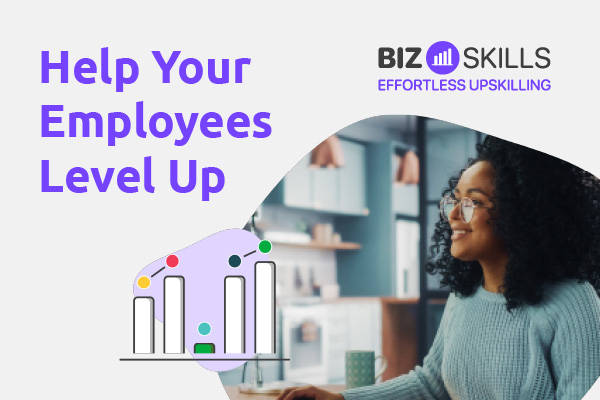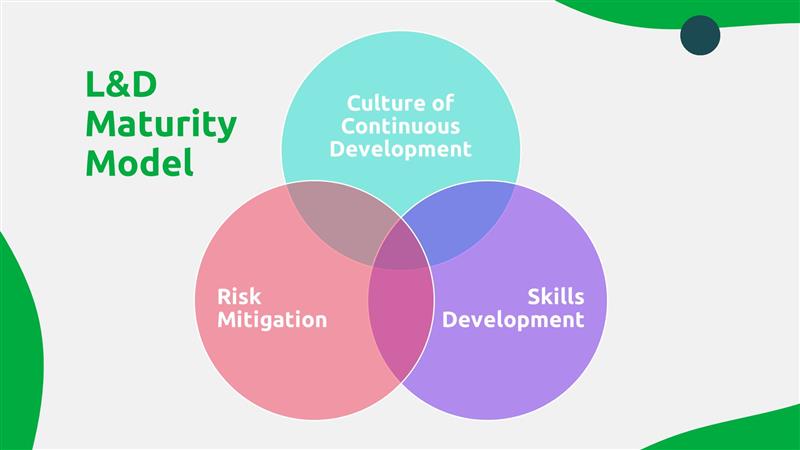A question we often get from clients is “Where do I stack up against everyone else?” That’s why BizLibrary designed a maturity model to help L&D professionals answer just that question. But we didn’t stop there! We took it a step further to help these leaders see how they can evolve their programs as well.
The Three Lenses
There are usually three distinct areas that training programs fall under. Think of these as concentric circles that overlap and represent various moments in time in the evolution of your program. One year, you may have strategic business initiatives focused on an DE&I program that would fall under “Risk Mitigation” while another may be focused on upskilling future leaders. By viewing these as three separate but equal pillars of your L&D program, you can prioritize specific areas as your program grows over time.
- Risk Mitigation – ensures compliance and lowers chance of risk
- Skills Development – ensures skills proficiency
- Culture of Continuous Development – ensures talent is available for the jobs of tomorrow
All three have to be considered to move any program forward.
Let’s break all of these down a bit more. Each has 5 stages.
Risk Mitigation
This is focusing on compliance and managing risk.
Check the Box: This is simply a training that exclusively focuses on meeting the minimum requirements according to local or federal law. Training is usually just focused on compliance. Think annual harassment training.
Expanded Risk: Organizations that have a program at the expanded risk stage often add a bit more training on high-target risk areas, e.g. cybersecurity. While there’s a bit more content, the focus of this step falls on the side of risk aversion.
Top-Down Change: At this stage, management steps in to promote learning internally to reinforce cultural expectations through a top-down, waterfall approach. Generally, this is seen as seen as non-strategic and compliance is attained from punishment avoidance.This is a bit of a band-aid approach but is often seeing expanded training curriculum in more specific courses whether those be DE&I specific initiatives or workplace safety type courses.
The largest gap in stages is between Top-Down and Empowerment.
Empowerment: In this stage, training isn’t happening to learners, meaning that it’s not thrust upon them, but instead, they are active participants. This stage ties training to culture and company values. All employees are empowered with information and policies to make informed decisions. Everyone is held equally accountable to making good decisions. Policies are well documented and the reasons for them are clearly understood by all. Areas of focus expand beyond loss aversion and into progressive culture.
For example, one of our core values is Smarter Every Day. Employees can search our full content library to learn the skills they want to when they want to. They also have the opportunity to attend seminars or classes on topics related to their jobs. Aside from that, our People Operations team always has an activity planned for us tying to one of our core values during our quarterly meetings!
Strategic Integration: Risk and compliance become fully integrated with the overall business objectives. The program is not seen as a mechanism to avoid loss, but a key component of business performance. There is unwavering support from all executives, and all employees understand their responsibility to maintaining the company’s culture of compliance.
BizLibrary takes strategic integration to heart with our core value of Respect Others. During our onboarding we have new hires share facts about themselves, meet with our CEO and other leadership, and do a scavenger hunt to meet current team members. Aside from that, we recognize employees with our annual CVAs (Core Value Awards), each tying to a core value we have.
Skills Development
Departmental: This stage of skills development has no L&D support and is siloed in each department. That means leaders are administering training and all employees may not be learning the same skills. An example here would be just offering training on a specific software to a specific department.
Reactive: In this stage, leaders turn to HR and L&D for help. L&D responds with training that is assigned and typically event based. This could be utilized when one team has a big blunder, say a communication error, and L&D steps in with training on communication techniques to help the team.
Targeted: Here is where L&D begins to take a more involved approach. They start to launch programs throughout the organization, such as onboarding or new manager training. These trainings are specific to an employee’s current role but is still not a strategic process as there is little involvement from c-suite leaders.
Expansion: This is the first strategic stage of this maturity model as functional leaders begin to collaborate with L&D and the training effort. L&D begins to proactively train across departments for both current and future skills development.
Functional Partnering: This stage has strong support from the executive team. Leaders have an integral role in the development strategy and execution, and there’s collaboration and shared ownership in the program. Development is seen as a key strategy to achieve the company’s goals and the program includes both training as well as mechanisms for skills demonstration and feedback. Training is still assignment based with little opportunity for meaningful engagement in self-development. An example here would be a specific customer-service training. The training has buy-in from all levels and is tied to an overall goal, but it is still an assigned course and there is a lack of personalization.
Culture of Continuous Development
Broad offering: This stage has elective learning by employees from a vast content library. However, the trainings selected may not correlate to the employees current or career goals. This library might also be limited to subsect of employees, such as middle managers.
Personalized: In this stage, employees can explore learning for their personal growth.Elective offerings are curated based on a learner’s unique needs and preferences with an emphasis on both their current role development as well as exposure to skills that support career progression.
Perhaps an employee is interested in management. They could then explore trainings that tie into management skills in order to prepare for a role when the option presents itself.
Development-focused: In this stage,in addition to providing learners with elective training, there are employee-initiated opportunities to demonstrate skills and receive feedback. Managers can play an integral role in ensuring learners success. SMEs can also play a vital role in the program’s success.
Career Acceleration: Participation and completion of skills development is clearly tied to career acceleration. Functional leaders rely on the L&D program to equip employees with the skills to succeed and emphasize internal hiring and promoting based on the results of the program.
Strategic Integration: Here L&D becomes fully integrated with the overall business objectives and is a key pillar to an overall talent development and retention strategy. There’s unwavering support the executive team and employees understand their responsibility to participate in the culture of life-long learning! They know how it impacts market advantage and business performance and they are willing to adopt the program and participate throughout the organization.
Success Factors to Moving Forward
It’s important to focus on these three lenses (risk mitigation, skills development, and continuous learning) before moving further. Here are some of the critical focus areas to more from your current step to your organization’s learning future:
- Alignment with leaders – tying training to business objectives
- Objectives and metrics – ways to measure success of a program
- Curriculum and career path mapping – selecting the curriculum and aligning skills to roles
- Content mapping and campaigns – mapping content to skills
- Program operations and resources – getting leadership buy-in and budget allowance
- Data analytics and insights – measuring the program and planning for the future
- Technology Infrastructure – planning the future and tying to talent strategy
For more information on personalized training, upskilling, reskilling, and career pathing, check out our webinar on BizSkills, our newest product offering that maps roles to content to skills!

